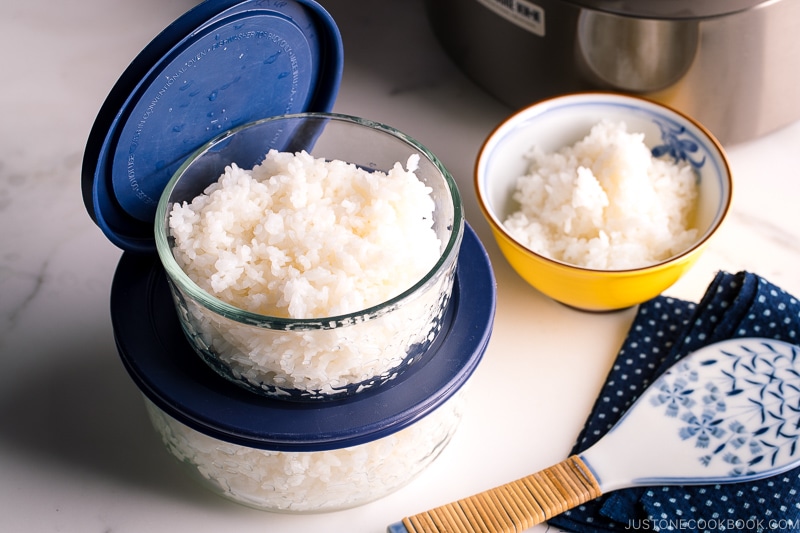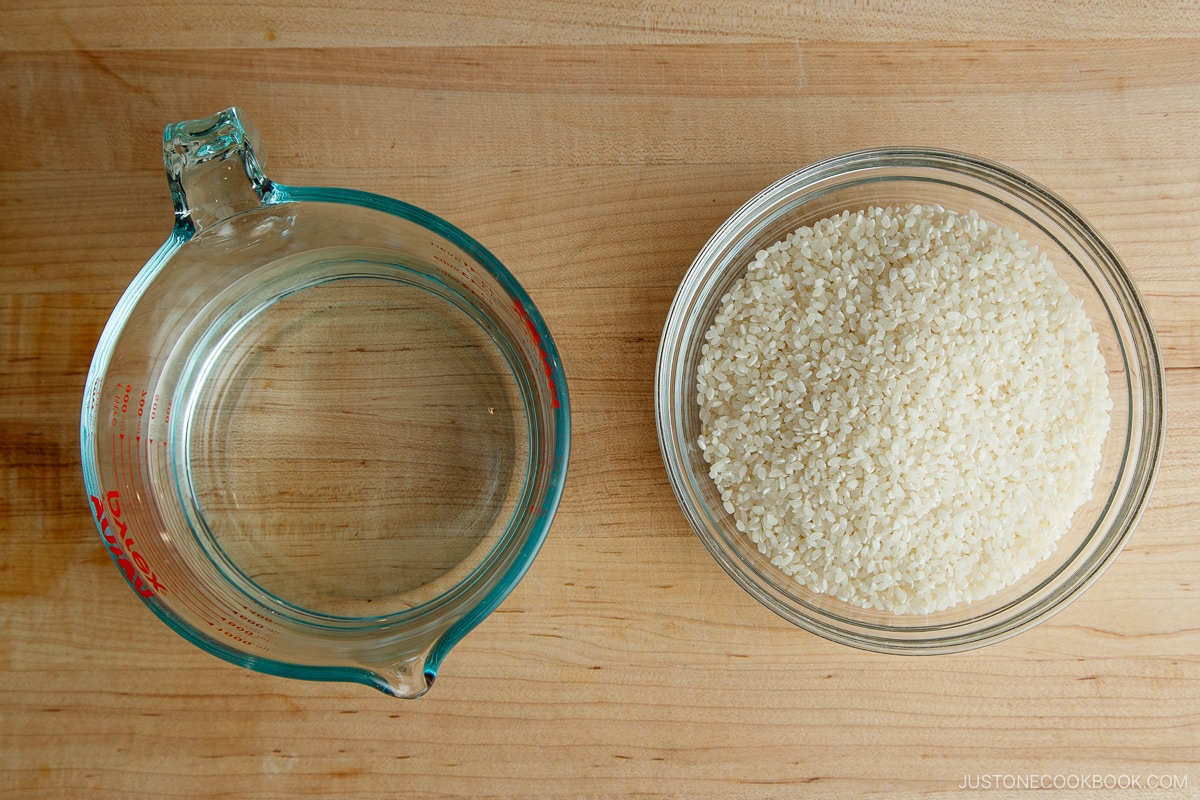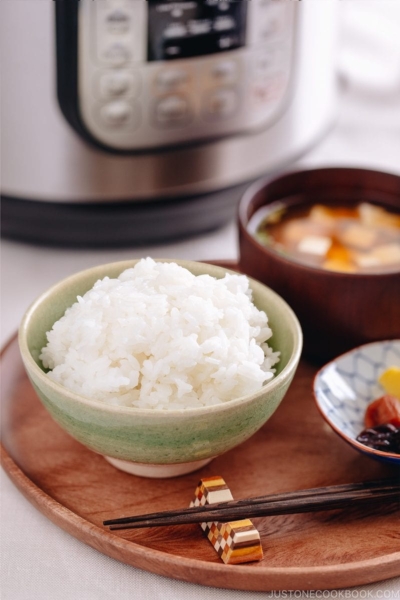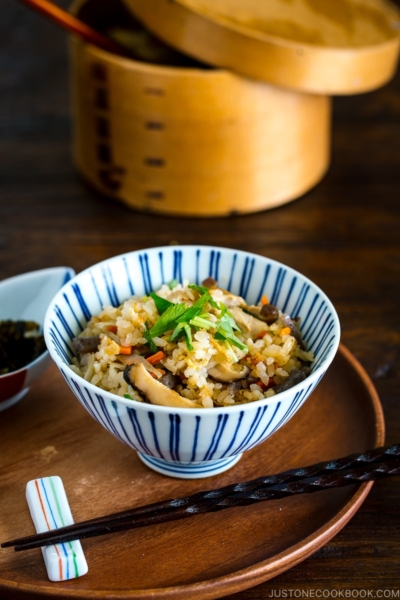No rice cooker? No problem! Learn how to make a pot of Japanese white rice on the stove. My simple tips and tricks will ensure that your steamed rice comes out perfectly every time.

Growing up in Japan, where rice is a staple food and the primary source of protein, cooking rice is not only a basic kitchen task but also an extremely important one. While an electric rice cooker with all the bells and whistles seems to be an essential kitchen gadget in most Asian kitchens, I understand that not everyone eats rice daily and may not own a rice cooker. It’s also handy to know how to make rice on the stove in case your rice cooker breaks unexpectedly or you’re craving rice while camping.
In this post, let’s get back to basics, and I’ll show you how to measure rice accurately, wash it properly, and finally cook Japanese rice in a pot on the stove.
Table of Contents
What is Japanese Short-Grain Rice?

Japanese rice is a type of Japonica short-grain rice that is short, plump, and rounded oval. It’s worth noting that outside of Japan, Japanese rice is often labeled as ‘sushi rice’ for marketing purposes. However, rice is used not just for making sushi, but also for everyday Japanese dishes.
What sets Japanese rice apart from long-grain rice varieties such as basmati or jasmine rice is its high water content, which means the texture is more tender and moist. The grains contain less amylose—a type of starch that separates rice grains— than the long grains, giving them a more sticky, chewy texture.
When cooked properly, the rice grains cling to each other without becoming mushy, allowing you to easily pick up the rice with chopsticks. You’ll also notice a beautiful glossy sheen on the surface of the rice. These unique characteristics of Japanese short-grain rice are essential because they allow us to make dishes like rice balls (onigiri) and sushi that need to stay in one piece.
Sometimes I hear people calling Japanese rice “sticky rice” due to its sticky texture, but please know that ‘sticky rice’ is technically a different type of rice known as sweet rice or glutinous rice, which we use for making mochi (rice cakes).
👉🏼 To brush up your knowledge, I highly recommend reading Everything You Need to Know about Japanese Rice and Types of Japanese Rice.

Best Japanese Rice Brands
When it comes to high-quality Japanese rice, I recommend the Koshihikari variety, which is available in various brands at Japanese grocery stores. Known for its sweet taste and fragrance, Koshihikari is the most popular variety in Japan. I personally prefer the Toyama-grown Koshihikari imported from Japan, which is available at Japanese grocery stores (I purchase mine at Nijiya Market in San Mateo).

For US-grown koshihikari rice, look for Shirakiku Rice, Tamaki Gold, and Tamanishiki Super Premium Short Grain Rice. For brown rice, we enjoy Genmai Sukoyaka Brown Rice and Koshihikari Premium Sprouted Brown Gaba Rice.
There are also other new cultivars such as Hitomebore, Akitakomachi, Tamanishiki, Tsuyahime, and so on. Each of them has unique characteristics that are different from Koshihikari.

What Kind of Pot to Use
Use a heavy-bottomed pot when cooking rice. The even heat distribution prevents the bottom of your rice from easily getting burnt. Personally, I love using Staub, especially for cooking rice. Compared to other popular Dutch oven brands, Staub features a better, tight-fitting lid that traps all the steam inside.
An alternative option I recommend is a donabe—a Japanese earthenware clay pot. If you plan to use a donabe, I have a separate post on How to Cook Japanese Rice in a Donabe.
How to Measure Rice and Water
In Japan, rice is always measured with a rice cooker cup, which is 180 ml or American ¾ cup. To measure correctly, overfill a rice cooker cup (or a ¾-cup measure works well for this) with rice and level it off. Failing to level it off may result in your rice not having enough water to cook properly.

Rice-to-Water Ratio
One of the reasons people often struggle to make Japanese rice is due to using the wrong amount of water. There is a lot of misinformation online. To cook Japanese short-grain white rice, the correct rice-to-water ratio is as follows:
The golden rule for the rice-to-water ratio [volume] is 1:1.1 (or 1.2).
This means:
- This means you will need 10–20% more water than rice.
- 1 rice cooker cup (180 ml) of rice – 200 ml of water
- 1 US cup (240 ml) of rice – 1⅛ cups of water (or 264 ml since the rounded-up cup measurement is not accurate)
I recommend getting a rice cooker cup (you can get it on Amazon) and using metrics to measure your water.

How to Wash the Rice
The technique of washing rice is often discussed, and each culture likely follows a different approach.

Here are the quick key points:
- Wash rice in cold running tap water; never use warm/hot water.
- Do not use a metal strainer to wash rice because it can break the rice.
- Discard the first rinsing water immediately before the rice starts absorbing impurities.
- Use your fingers to gently agitate the wet rice grains in a circular motion for 10–15 seconds. The bowl should have very little water, which allows the grains to rub against each other. Rinse and wash one to two more times until the water is almost clear.
Why Do We Soak the Rice?
Aside from using the incorrect amount of water for rice, another reason people struggle to make perfect Japanese rice is not soaking the rice.
Since soaking isn’t necessary for other types of rice, you might assume it’s a waste of time or unnecessary. However, this results in rice that isn’t cooked through because the core remains hard.
Consider the Japanese short-grain rice kernel: it has a plump body and requires a longer time to absorb moisture to the core. That’s why we give it a headstart by soaking the rice for at least 20-30 minutes.
How to Cook the Japanese Rice on the Stove
After 20-30 minutes of soaking, we’re now ready to cook the rice!
- Cover the pot with the lid, leaving a small gap, and bring it to a boil over medium heat. Take a quick peek to see if the water is boiling.
- Once the water is boiling, turn the heat to low and cook, covered, for 12–13 minutes.
- When it’s done cooking, open the lid and take a quick peek to check if the water is completely absorbed. If there‘s water left, close the lid and cook for a little longer.
- Remove from the stove and let it steam with the lid on for another 10 minutes.
- After 10 minutes, uncover the pot and fluff the rice with a rice paddle. It‘s now ready to serve.

Cooking Tips
Here are 5 main tips to cook a perfect pot of glossy and tender Japanese rice:
- Wash and rinse the rice. Always start by quickly rinsing and washing the rice a few times to help remove the natural occurrence of arsenic and impurities.
- Use a heavy-bottom pot with a tight-fitting lid. If your lid fits loosely, put a clean kitchen cloth between the lid and the pot to keep the steam in.
- Always soak the rice in water for 30 minutes. Rice has been sitting in the bag dried after milling, so it needs moisture to revive the texture. You must give it enough time for the rice to absorb water so that it has a perfect texture after cooking.
- DO NOT open the lid while cooking! This is a big no-no when it comes to cooking Japanese rice. I learned from my experience to catch the indication of “boiling” by sound. However, until you do, it’s okay to “quickly peek” inside to see if it’s boiling.
- Rest and fluff. Once the rice is cooked, let it rest for 10 minutes to steam fully, and then fluff to help evaporate the excess moisture.
Best Way to Store Cooked Rice

What’s the best way to store the leftover rice? Japanese people always freeze the rice! We never refrigerate the rice because it gets hard.
I use a glass container with a lid. If you already know how much rice you will be using, pack away the freshly made rice immediately to seal in the moisture. Be sure to let it cool before putting it in the freezer.
To reheat the rice, open the lid, place a wet paper towel over the glass container, and microwave. It’s just like freshly made rice.
Pro Tip: I always pack different portions (one serving and two servings) so we can defrost the right amount.
Other Ways to Cook Japanese Rice

There are different methods to cook Japanese rice at home. Each method has its advantages, and Japanese households often own a few cooking pots/gadgets for different occasions and needs.
- How to Cook Japanese Rice in a Rice Cooker
- How to Cook Japanese Rice in a Pot on the Stove
- How to Cook Japanese Rice in an Instant Pot
- How to Cook Japanese Rice in a Donabe on the Stove
- How to Cook Short-Grain Brown Rice in a Rice Cooker
- How to Cook Short-Grain Brown Rice in an Instant Pot


How to Cook Japanese Rice in a Pot on the Stove
Video
Ingredients
For 4 Rice Bowls (4⅓ cups, 660 g)
- 1½ cups uncooked Japanese short-grain white rice (2 rice cooker cups, 360 ml)
- 1⅔ cups water (400 ml)
For 6 Rice Bowls (6⅔ cups, 990 g)
- 2¼ cups uncooked Japanese short-grain white rice (3 rice cooker cups, 540 ml)
- 2½ cups water (600 ml)
For 8 Rice Bowls (8¾ cups, 1320 g)
- 3 cups uncooked Japanese short-grain white rice (4 rice cooker cups, 720 ml)
- 3⅜ cups water (800 ml)
For 10 Rice Bowls (11 cups, 1650 g)
- 3¾ cups uncooked Japanese short-grain white rice (5 rice cooker cups, 900 ml)
- 4⅛ cups water (1000 ml)
Instructions
- DO NOT use scaling (x 2 or x 3) for this recipe.
- Before You Start: Please note that Japanese short-grain white rice requires a soaking time of 20–30 minutes. The rice-to-water ratio is 1 to 1.1 (or 1.2) for short-grain white rice. The ratio for brown rice is different; to learn more, read how to cook short-grain brown rice in a rice cooker or Instant Pot.

- How to Measure: Overfill a plastic rice cooker cup (or use a ¾-cup measure) with uncooked short-grain rice and level it off. Put the rice in a large bowl. Repeat until you have the measured amount of rice needed. For this recipe, I measured 2¼ cups (3 rice cooker cups) of short-grain white rice. Tip: Without leveling it off, your rice will not have enough water to cook properly.

To Wash the Rice
- Quick Rinse: Add just enough tap water to the bowl to submerge the rice. Then, discard the water immediately. Tip: Rice absorbs water very quickly when you start rinsing, so this quick rinse helps remove impurities from the rice and prevent it from absorbing the first few rounds of milky water.

- Wash: Next, use your fingers to gently agitate the wet rice grains in a circular motion for 10–15 seconds. Don‘t use a strainer as it can break the rice. Tip: Using very little water allows the grains to rub against each other. It also reduces the absorption of impurities from the milky water.

- Rinse: Add tap water and immediately discard the cloudy water. Repeat one more time.

- Repeat the Wash and Rinse process (steps 2 and 3) one to two more times.

- Drain: When the water is almost clear, drain the rice completely.

- Use a fine-mesh sieve to drain and shake off any excess water. Do not leave it for more than 5 minutes as it can easily get too dry.

To Soak the Rice
- Put the well-drained rice and measured water in a heavy-bottomed pot with a tight-fitting lid(I use a 2.75-QT Staub here). For example, if you‘re cooking 2¼ cups uncooked Japanese short-grain white rice (3 rice cooker cups), add 2½ cups water (600 ml). Soak the rice for 20–30 minutes before cooking.

To Cook the Rice
- Cover the pot with a lid slightly ajar and bring it to a boil over medium heat. Take a quick peek to see if the water is boiling.

- Once the water is boiling, turn the heat to low and cook, tightly covered, for 12–13 minutes.

- When it‘s done cooking, open the lid and take a quick peek to check if the water is completely absorbed. If there‘s water left, close the lid and cook for a little longer.

To Steam the Rice
- Remove from the stove and let it steam with the lid on for another 10 minutes. Tip: This resting period is crucial for the rice to steam properly. Resist the urge to peek under the lid and release the steam during this time. After 10 minutes, uncover the pot and fluff the rice with a rice paddle. It‘s now ready to serve.

To Store
- Transfer the rice to airtight containers and close the lids to keep the moisture in. Let cool completely before storing the containers in the freezer (read my tutorial post on how to freeze rice).

Notes
Equipment
- 2.75-QT Cast Iron Pot (Staub)
Nutrition
Editor’s Note: This post was originally published on December 4, 2013. It was republished with a new video and more helpful content on March 15, 2024.








Hi,
thanks for the recipe, my rice cooking skills are definitly improving since i’m using it
The only thing I still struggle a bit with is my rice being slightly undercooked.
I tried a new batch with a bit more water following the provided instructions for the ratio in grams.
Visually the rice seems cooked but when I take a bite, the top part of the rice is still a little bit crunchy while the bottom part in the pot is nice, soft and sticky as it should be.
I’m still playing around with the water-rice ratio and will but I was wondering if there is anything I could to do save a batch if it still tastes crunchy after letting it steam for 10min away from the stove?
Should I add more water and recook it on the stove or do I let it steam a bit longer with a bit of added water?
Or do I then let the steam escape and is the batch ruined then?
Kind regards, Maxim
Hello Maxim, Thank you so much for reading Nami’s post and trying her recipe!
There can be several reasons why the top layer of rice may not cook through completely. It could be due to the type of pot you’re using, the quality of the rice and water, or even the altitude, so it can definitely be a bit tricky.
If you notice the rice isn’t fully cooked, feel free to add a little more water and cook it a bit longer. You might also try soaking the rice longer than what’s suggested in Nami’s recipe to see if that improves the results.
We hope this helps, and happy cooking!
thank you! what size staub are you using?
Hello Rebecca! Thank you for trying Nami’s recipe!
Nami used 2.75 QT for this recipe. https://amzn.to/4hqR3KE
Hope this helps!
You might want to offer an alternate ratio of weight instead of volume, as volume ratio may not allow scaling. I am a baker and I prefer the weight ratio. I typically use between 1 to 1.05 on Japanese white rice and final product never fails, unless other ingredients are added.
Hello, Minh. Thank you for reading Nami’s post and for providing suggestions.
In the recipe card, there are options for showing weight measurements. We sincerely hope this helps!
This recipe does not work AT ALL scaled up!
Making 1 cup works great, but every single time I make 2 cups, no matter how carefully I measure, the rice comes out under cooked, dry and hard!!! What’s going on??
Hello, Dee. Thank you for trying Nami’s recipe.
We’re sorry to hear your rice didn’t turn out nicely. The perfect rice-to-water ratio [volume] is 1:1.1 (or 1.2). If the 1.1 volume does not work for your rice, please add some extra water. We hope this works.
If I soak the rice for 20-30 minutes, should I drain it and add new water or cook it with the soaking water?
Hi, Silvia! Thank you for trying Nami’s recipe.
After you’ve soaked the rice in measured water, you can begin cooking with the remaining water in the pot. There’s no need to drain.
I hope this helps!
I was surprised to see you say Koshihikari rice—after trying a number of different rices, I came to the conclusion that Koshihikari is my favorite! I just moved from the east coast (where H Mart carried big bags) to Eureka, CA, where our local Japanese store has small bags that are quite expensive. I found a bag of Sekka at the Grocery Outlet last night, so that will do until I can get to the Bay Area and stock up.
Arigato!
Karina
Hello Karina! Thank you for reading Nami’s post. We are glad to hear you enjoyed it. 🥰
You might also like this post about a type of rice.
https://www.justonecookbook.com/japanese-rice-everything-you-need-to-know/
Enjoy!
I followed your recipe for 2 pax 330g with 200ml water and the rice was under cooked! so trying salvage it now by adding more water. hope this works!
Hi, Ming! Thank you for trying Nami’s recipe.
If the water is 200 ml, the uncooked rice should be 150 g (1 rice cooker cup = 180 ml). I hope this helps!
Yes! To save the rice, simply add extra water and simmer it for longer.🙂
Hey folks! I was wondering about the ratio instructions – it says that the ratio is 1:1.1 to 1:2 but, (unless my math is terribly rusty) the ratio from the portions in the instructions is 1:3, is that correct?
Hi, Ioannis! Thank you for trying Nami’s recipe.
The rice and water ratio is a volume ratio of 1:1.1 (or 1.2). So, 1 rice cooker cup (180 ml) rice – 200 ml water.
Hope this helps! 🙂
Ah, but because the instructions are rice in weight and water in ml it comes out weird like that?
Hi, Ioannis! The ingredient list includes weight, volume, and cup measurements. We hope that the “Rice-to-Water Ratio” in this post is explained further with an example. We hope this helps!🙂
When my family and I were in Fukuoka, the place we stayed in had no rice cooker, so this guide/recipe was really helpful and we were able to make delicious donburi and onigiri!
Hi, Kae! Aww. We are overjoyed to hear Nami’s instruction was helpful in Fukuoka! 🤗
Thank you for trying Nami’s recipe and sharing your feedback with us. Happy cooking!
Despite my interest in cooking, I am very bad at it. Yet I managed to get good rice with this recipe and I used it to make tuna rice balls with a bit of furikake. My family was impressed and they loved them.I did not see the soaking comment, though, so there’s obviously room for improvement. Thank you.
Hi Julian! We are glad to hear you and your family enjoyed it.
Thank you so much for reading Nami’s post and trying her recipe.
Happy Cooking!
Today, I managed to cook rice perfectly, a feat I never thought I’d be able to accomplish when making a Japanese dish. I tried to use this recipe years ago as a kid, only to forget to take the rice off the flame during the steaming phase. For about 10 years that convinced me I was unable to do this, until today. Thank you so much for sharing these recipes with us all!
Hi, Azzy! Thank you so much for reading Nami’s post and trying her recipe!
We’re pleased to hear your rice turned out nicely! Thank you for sharing your experiences with us.
Happy cooking!
Hello, I have always cooked rice this way, and it always yields perfect results, but yesterday I took your advice and froze a batch for the first time.
I followed your instructions to the letter and had some for dinner today. I have to say, I think it actually improved the flavour. Thanks for the tips, and could I encourage everybody to click on the link and give it a try.
I am only sorry that I didn’t do this years ago, because as much as I love rice, sometimes you don’t want to go to the bother of cooking it when you are short of time. Thanks to you, this is a game-changer. I am very grateful.
Hi Paul! We are so happy to hear Nami’s instructions helped make the best rice!
Thank you for trying her recipe and sharing your experience with us.
Happy Cooking!🥰